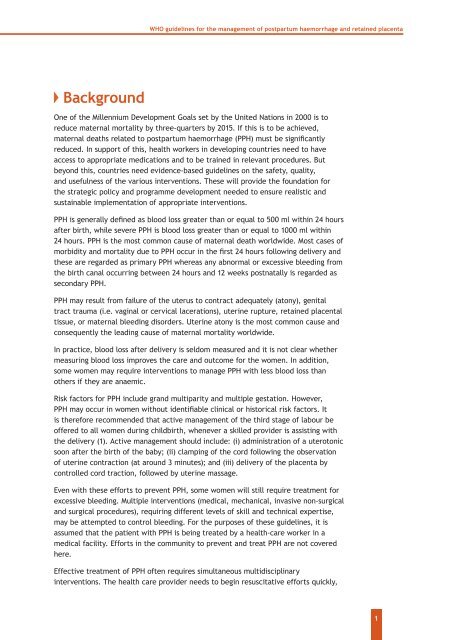WHO guidelines for the management of postpartum haemorrhage ...
WHO guidelines for the management of postpartum haemorrhage ...
WHO guidelines for the management of postpartum haemorrhage ...
You also want an ePaper? Increase the reach of your titles
YUMPU automatically turns print PDFs into web optimized ePapers that Google loves.
<strong>WHO</strong> <strong>guidelines</strong> <strong>for</strong> <strong>the</strong> <strong>management</strong> <strong>of</strong> <strong>postpartum</strong> <strong>haemorrhage</strong> and retained placenta<br />
Background<br />
One <strong>of</strong> <strong>the</strong> Millennium Development Goals set by <strong>the</strong> United Nations in 2000 is to<br />
reduce maternal mortality by three-quarters by 2015. If this is to be achieved,<br />
maternal deaths related to <strong>postpartum</strong> <strong>haemorrhage</strong> (PPH) must be significantly<br />
reduced. In support <strong>of</strong> this, health workers in developing countries need to have<br />
access to appropriate medications and to be trained in relevant procedures. But<br />
beyond this, countries need evidence-based <strong>guidelines</strong> on <strong>the</strong> safety, quality,<br />
and usefulness <strong>of</strong> <strong>the</strong> various interventions. These will provide <strong>the</strong> foundation <strong>for</strong><br />
<strong>the</strong> strategic policy and programme development needed to ensure realistic and<br />
sustainable implementation <strong>of</strong> appropriate interventions.<br />
PPH is generally defined as blood loss greater than or equal to 500 ml within 24 hours<br />
after birth, while severe PPH is blood loss greater than or equal to 1000 ml within<br />
24 hours. PPH is <strong>the</strong> most common cause <strong>of</strong> maternal death worldwide. Most cases <strong>of</strong><br />
morbidity and mortality due to PPH occur in <strong>the</strong> first 24 hours following delivery and<br />
<strong>the</strong>se are regarded as primary PPH whereas any abnormal or excessive bleeding from<br />
<strong>the</strong> birth canal occurring between 24 hours and 12 weeks postnatally is regarded as<br />
secondary PPH.<br />
PPH may result from failure <strong>of</strong> <strong>the</strong> uterus to contract adequately (atony), genital<br />
tract trauma (i.e. vaginal or cervical lacerations), uterine rupture, retained placental<br />
tissue, or maternal bleeding disorders. Uterine atony is <strong>the</strong> most common cause and<br />
consequently <strong>the</strong> leading cause <strong>of</strong> maternal mortality worldwide.<br />
In practice, blood loss after delivery is seldom measured and it is not clear whe<strong>the</strong>r<br />
measuring blood loss improves <strong>the</strong> care and outcome <strong>for</strong> <strong>the</strong> women. In addition,<br />
some women may require interventions to manage PPH with less blood loss than<br />
o<strong>the</strong>rs if <strong>the</strong>y are anaemic.<br />
Risk factors <strong>for</strong> PPH include grand multiparity and multiple gestation. However,<br />
PPH may occur in women without identifiable clinical or historical risk factors. It<br />
is <strong>the</strong>re<strong>for</strong>e recommended that active <strong>management</strong> <strong>of</strong> <strong>the</strong> third stage <strong>of</strong> labour be<br />
<strong>of</strong>fered to all women during childbirth, whenever a skilled provider is assisting with<br />
<strong>the</strong> delivery (1). Active <strong>management</strong> should include: (i) administration <strong>of</strong> a uterotonic<br />
soon after <strong>the</strong> birth <strong>of</strong> <strong>the</strong> baby; (ii) clamping <strong>of</strong> <strong>the</strong> cord following <strong>the</strong> observation<br />
<strong>of</strong> uterine contraction (at around 3 minutes); and (iii) delivery <strong>of</strong> <strong>the</strong> placenta by<br />
controlled cord traction, followed by uterine massage.<br />
Even with <strong>the</strong>se ef<strong>for</strong>ts to prevent PPH, some women will still require treatment <strong>for</strong><br />
excessive bleeding. Multiple interventions (medical, mechanical, invasive non-surgical<br />
and surgical procedures), requiring different levels <strong>of</strong> skill and technical expertise,<br />
may be attempted to control bleeding. For <strong>the</strong> purposes <strong>of</strong> <strong>the</strong>se <strong>guidelines</strong>, it is<br />
assumed that <strong>the</strong> patient with PPH is being treated by a health-care worker in a<br />
medical facility. Ef<strong>for</strong>ts in <strong>the</strong> community to prevent and treat PPH are not covered<br />
here.<br />
Effective treatment <strong>of</strong> PPH <strong>of</strong>ten requires simultaneous multidisciplinary<br />
interventions. The health care provider needs to begin resuscitative ef<strong>for</strong>ts quickly,<br />
1
















